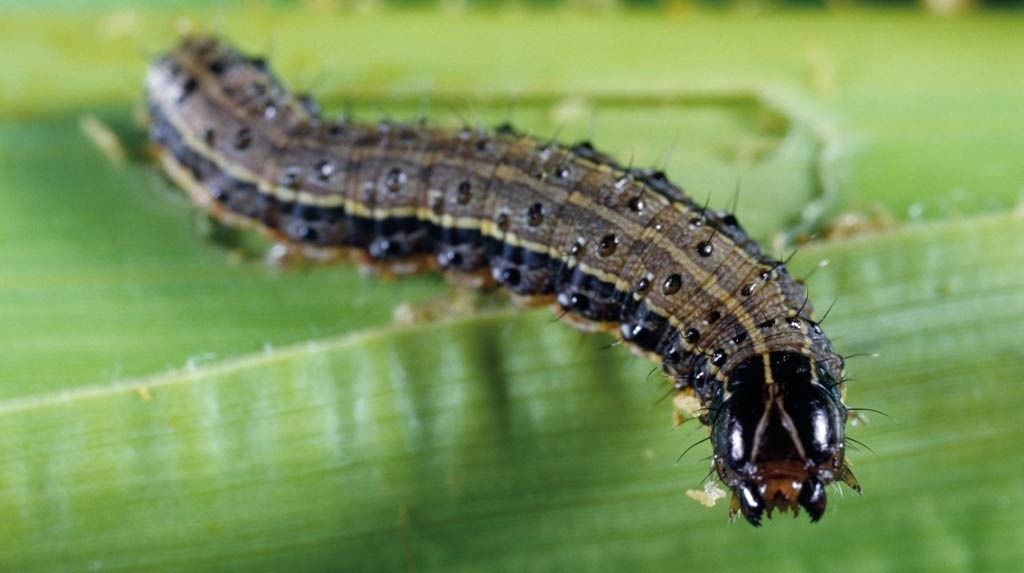icipe Push-Pull technology halts fall armyworm rampage
The Push-Pull technology involves intercropping cereals with a pest repellent plant, such as Desmodium, which drives away or deters stemborers from the target food crop. An attractant trap plant, for instance, Napier grass (Pennisetum purpureum), is planted around the border of this intercrop, to attract and trap the pests. As a result, the food crop is protected from the pests. In addition, Desmodium (D. uncinatum or D. intortum) stimulates suicidal germination of Striga and inhibits its attachment to the roots of cereal crops by hindering the growth of its haustorium. Moreover, Desmodium improves soil nitrogen, phosphorous, carbon, and biodiversity. The technology has also been noted to reduce aflatoxin contamination, and more recently, the fall armyworm that has invaded several African countries. Push–Pull also has significant benefits for dairy farming, since Desmodium and Napier or Brachiaria grass are high-quality animal fodder plants. Therefore, Push-Pull improves household nutrition, incomes, and overall livelihoods.
You may read the whole article at:
Source: ICIPE – News
Scientists find push-pull technology curbs armyworms
Researchers at the Nairobi-based International Insect Physiology and Ecology (Icipe) have found a technology that will help curb fall armyworms, which have ravaged maize in the country.
The scientists have established that the push-pull technology advanced by Icipe is effective in controlling the fall armyworm hence providing an appropriate, handy, environmentally friendly and cost-effective approach for managing the pest.
The technology involves intercropping cereal crops with desmodium-type pest repellent legumes and planting an attractive forage plant such as Napier grass as a border.
Icipe Senior Research Scientist Charles Midega said the new technology is providing a suitable, accessible, environmentally friendly and cost-effective strategy for management of the pest.
The intercrop emits a blend of compounds that repel away stem borer moths, while the border plants emit semi-chemicals that are attractive to the pests.
“Our findings reveal that fall armyworm infestation is more than 80 percent lower in farms where the climate-adapted push-pull is being used, with associated increases in grain yields, in comparison to mono-crop plots,” Midega said.
You may read the whole article at:
Researchers have found intercropping maize with drought-resistant greenleaf desmodium and planting Brachiaria grass on the farm’s edge helps curb fall armyworms.
Desmodium and Brachiaria grass are high quality animal fodder plants.
The leguminous greenleaf desmodium becomes repellent, emitting a blend of compounds that help push armyworms away from maize while Brachiaria Mulato II grass around field edge produces chemicals attractive to the pests.
You may read the whole article at:
Source: The East African
How to combat the fall armyworm
The fall armyworm (FAW) which was first detected in Uganda in 2016 and caused havoc last year is back.
Towards the end of last year the incidence of the pest was reducing but it has since sprung and farmers are left in dilemma on what to do next.
However there are number of both scientific and rudimentary practices for farmers to adhere to in a bid to control the pest infestation.
You may the whole article at:
Source: Daily Monitor
Push-pull technology can control fall armyworm
Desmodium is a perennial cover crop which is able to exert its Striga control effect even when the host crop is out of season, and together with Brachiaria or Napier grass, protect fragile soils from erosion. It also fixes nitrogen, conserves soil moisture, enhances insect abundance and diversity and improves soil organic matter. Desmodium enables cereal cropping systems to be more resilient and adaptable to climate change while providing essential environmental services. It also makes farming systems more robust and sustainable. In addition, Push-Pull also controls maize ear rots and mycotoxins, while improving soil health, producing high quality fodder for livestock. Therefore, the technology facilitates crop-livestock integration thus expanding farmers’ income streams. Farmers using ‘push–pull’ technology not only use it for pest control but also to reduce the devastating effects of the parasitic weed Striga hermonthica through the effects of desmodium. The technology is appropriate and economical to the resource-poor smallscale farmers in the East Africa region as it is based on locally available plants, no expensive external inputs, and fits well with traditional mixed cropping systems in Africa.
Source: Organic farmer


I was curious if you ever considered changing
the layout of your blog? Its very well written; I love what
youve got to say. But maybe you could a little more in the way of content so people could connect
with it better. Youve got an awful lot of text for
only havin 1 or 2 images. Maybe you could space it out better?
Hi, thanks for the insight. We will look into that.
Does your site have a contact page? I’m having a tough time locating it but, I’d like to shoot you an email. I’ve got some creative ideas for your blog you might be interested in hearing. Either way, great site and I look forward to seeing it develop over time.
Thank you for the feedback. Yes, here is our contact us page: https://zaoistech.com/contact-us/. Thank you
Keep working ,terrific job!
Hi. I’m glad he found zaoistech.com website, I really like
it, the article is very useful and I shared it!
Great success with this site!
Thank you.
Hello, i think that i saw you visited my blog so i came to “return the favor”.I’m trying to find things to
improve my web site!I suppose its ok to use a few of your ideas!!
Yes, It’s okay. Thank you.